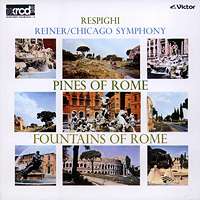
Orchestral panoply
Respighi's
Pines and Fountains -
appreciated by
ROBERT ANDERSON'Fritz Reiner has the right qualities for this music.'
|

|
Except for a mostly vertical tendency, pines and fountains have little in common.
Yet in a moment of aberration, recalling that Respighi wrote The Fountains
eight years before The Pines, I started listening to the latter in watery
mood. It was some bars before Respighi disabused me, which just shows that pine
trees do not go readily into music. Birds may be introduced, as at the end of the
'Janiculum' movement, but birds will perform as willingly in a poplar or a palm.
The fact is that Respighi based The Pines of Rome not so much on the trees
as on their location. The umbrella pines of the Villa Borghese may be different
from the clumps along the Appian Way, but it is the public bustle of the one and
the dogged military associations of the other that give Respighi his cue.
It is much the same with The Fountains. Water can flow through music
in ways as diverse as those employed by Beethoven in his 'Pastoral' brook or by
Debussy when contemplating the English Channel (he was on Eastbourne front at
the time) for La mer. But Respighi, master of innumerable orchestral tricks
after study with Rimsky-Korsakov, was canny enough to couple his four fountains
to successive times of day, so that the change from dawn to sunset can be added
to progress from the 'Villa Giulia' with its statues representing Tibor and Arno
to the 'Villa Medici', where Galileo was locked up by the Inquisition, with its
fountains amid ilexes rather than pines.
Continue >>
Copyright © 15 October 2003
Robert Anderson, London UK

|

